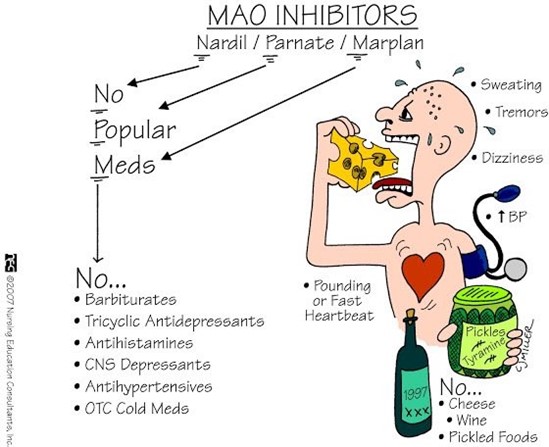The nurse is identifying tertiary prevention strategies to implement for this client.
Select the three actions the nurse should take.
Insist that the client explain the reason for their bruises.
Inform the client that their child is being abusive toward them.
Report suspected maltreatment to the appropriate agency.
Confront the client's child about the client's injuries.
Ask the client how the fracture occurred.
Conduct the interview with the client privately.
Correct Answer : C,E,F
In a situation where maltreatment is suspected, it is important for the nurse to report their concerns to the appropriate agency. The nurse should also ask the client how the fracture occurred and conduct the interview with the client privately, without the presence of their child, to gather more information and assess the situation.
Nursing Test Bank
Naxlex Comprehensive Predictor Exams
Related Questions
Correct Answer is B
Explanation
Tranylcypromine is a monoamine oxidase inhibitor (MAOI) medication used to treat depression. MAOIs inhibit the activity of the enzyme monoamine oxidase, which helps regulate the breakdown of certain neurotransmitters, including tyramine. Tyramine is typically broken down by monoamine oxidase, but when taking an MAOI, the enzyme's inhibition can lead to an excessive accumulation of tyramine in the body.
Tyramine-rich foods, such as aged cheeses, cured meats, and certain fermented or pickled foods, contain high levels of tyramine. Ingesting these foods while taking an MAOI can lead to a sudden release of stored norepinephrine, causing a hypertensive crisis.
Hypertension is a potentially serious adverse effect of MAOI therapy combined with tyramine-rich food ingestion. Symptoms of a hypertensive crisis can include severe headache, palpitations, chest pain, sweating, blurred vision, and in severe cases, it can lead to stroke or other cardiovascular complications.
Hematuria refers to the presence of blood in the urine and is not a known adverse effect of tranylcypromine or related to tyramine-rich food ingestion.
Tinnitus refers to the perception of ringing or noise in the ears and is not a known adverse effect of tranylcypromine or related to tyramine-rich food ingestion.
Hyperglycemia, or high blood sugar levels, is not a known adverse effect of tranylcypromine or related to tyramine-rich food ingestion. However, it's important to note that tranylcypromine may interact with certain diabetes medications, so it's essential to consider the client's overall medical history and potential drug interactions.

Correct Answer is B
Explanation
The guideline of being able to fit one finger between the mattress and the side of the crib ensures that there is a safe space to prevent entrapment and suffocation risks.
Placing a newborn on a pillow for sleep is unsafe. Infants should be placed on their backs to sleep on a firm, flat surface without pillows, blankets, or soft bedding. This reduces the risk of suffocation or sudden infant death syndrome (SIDS).
Attaching a pacifier to the newborn's clothing with a string is hazardous. Strings and cords pose a strangulation risk. Pacifiers should be used according to safe guidelines, but they should not be attached to the baby's clothing with any type of string or cord.
Placing a newborn's crib near a heat vent can result in overheating, which is a safety concern. It is important to keep the baby's sleep environment at a comfortable temperature without direct exposure to heat sources or drafts
Whether you are a student looking to ace your exams or a practicing nurse seeking to enhance your expertise , our nursing education contents will empower you with the confidence and competence to make a difference in the lives of patients and become a respected leader in the healthcare field.
Visit Naxlex, invest in your future and unlock endless possibilities with our unparalleled nursing education contents today
Report Wrong Answer on the Current Question
Do you disagree with the answer? If yes, what is your expected answer? Explain.
Kindly be descriptive with the issue you are facing.
